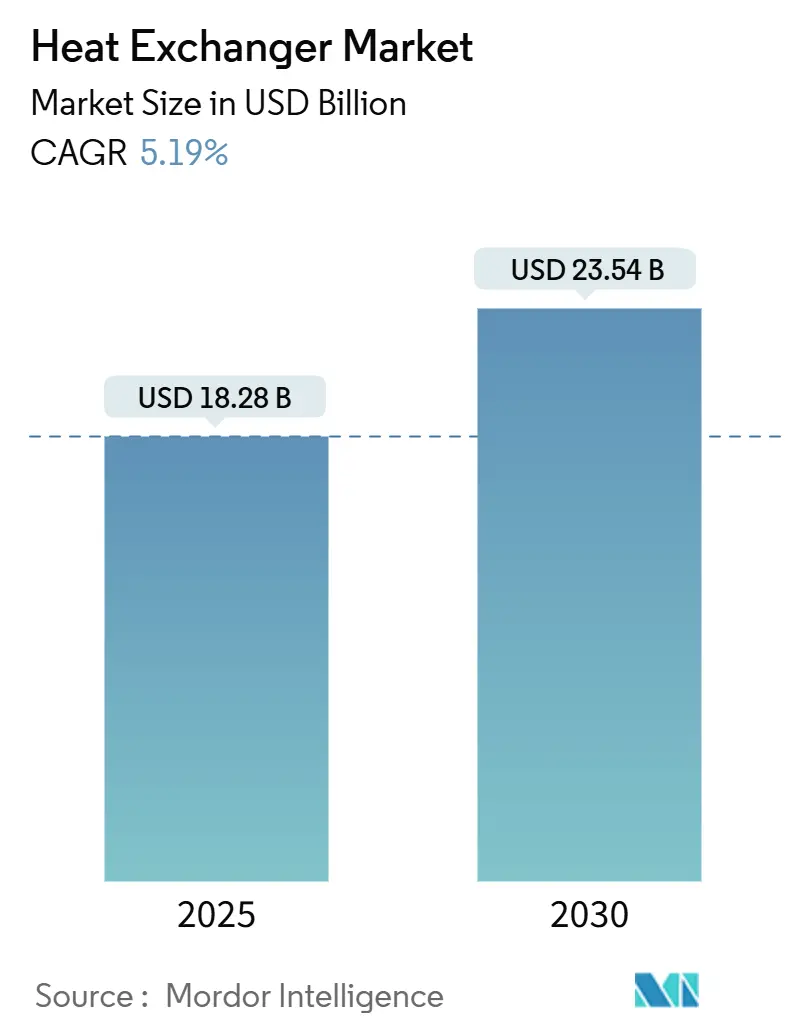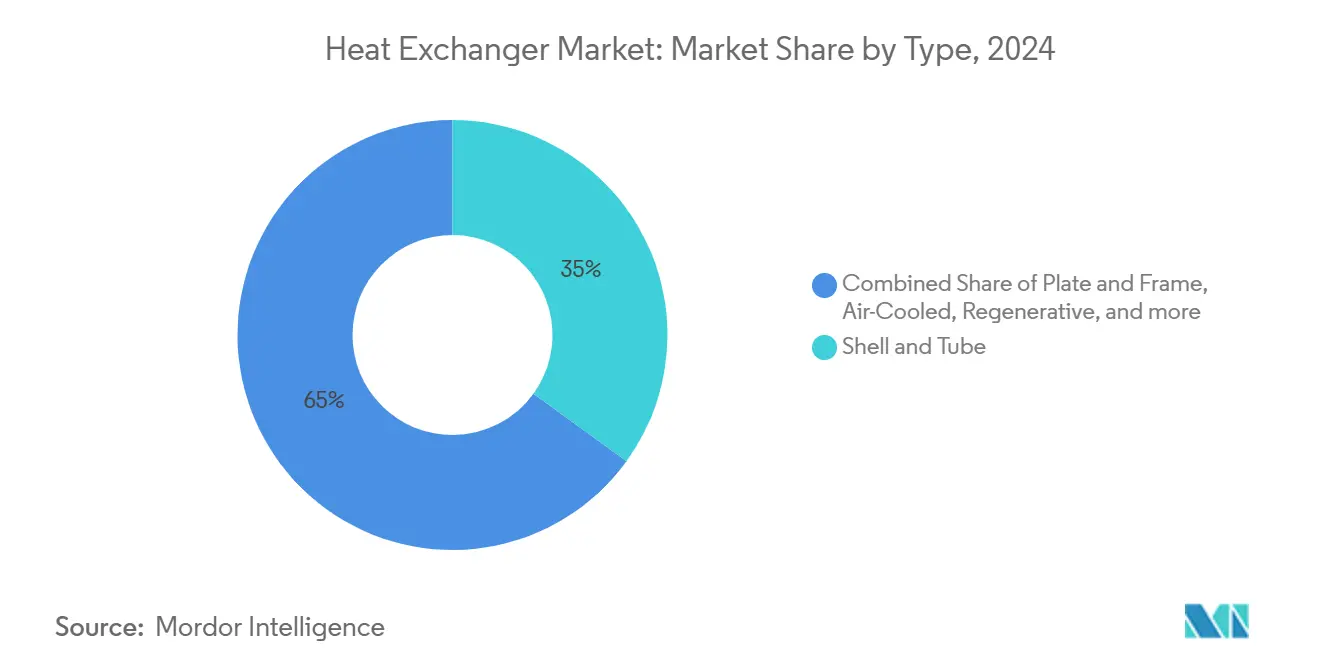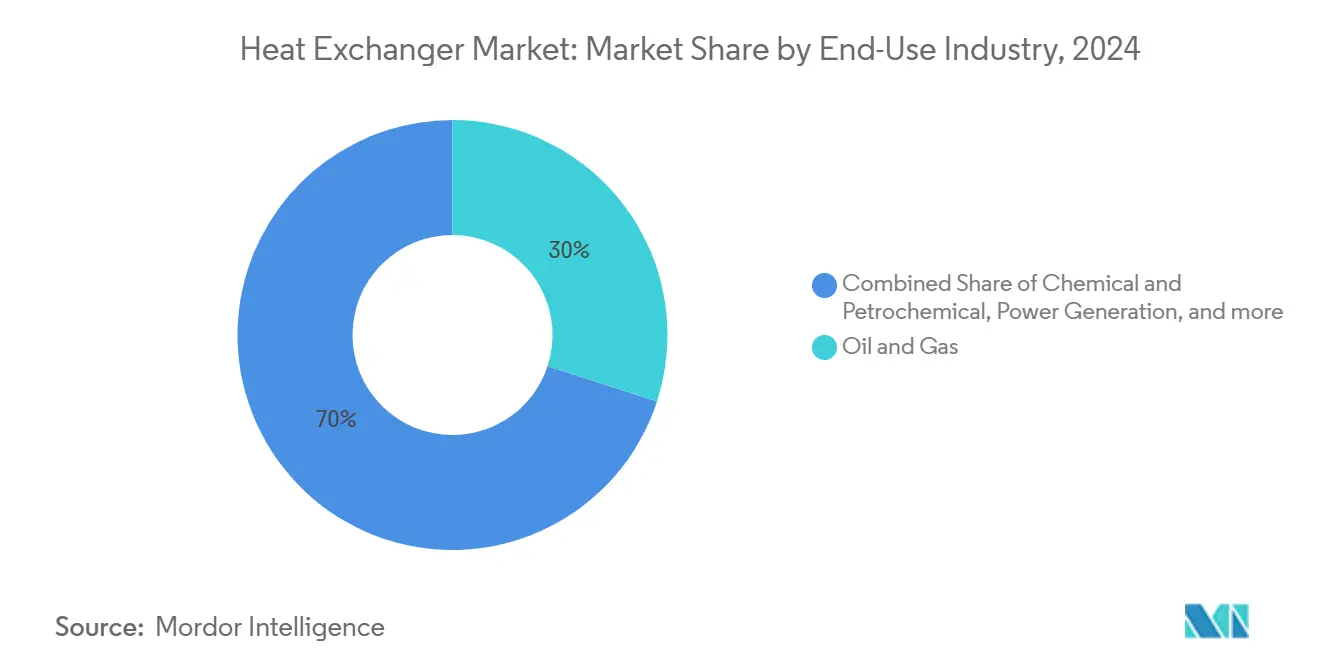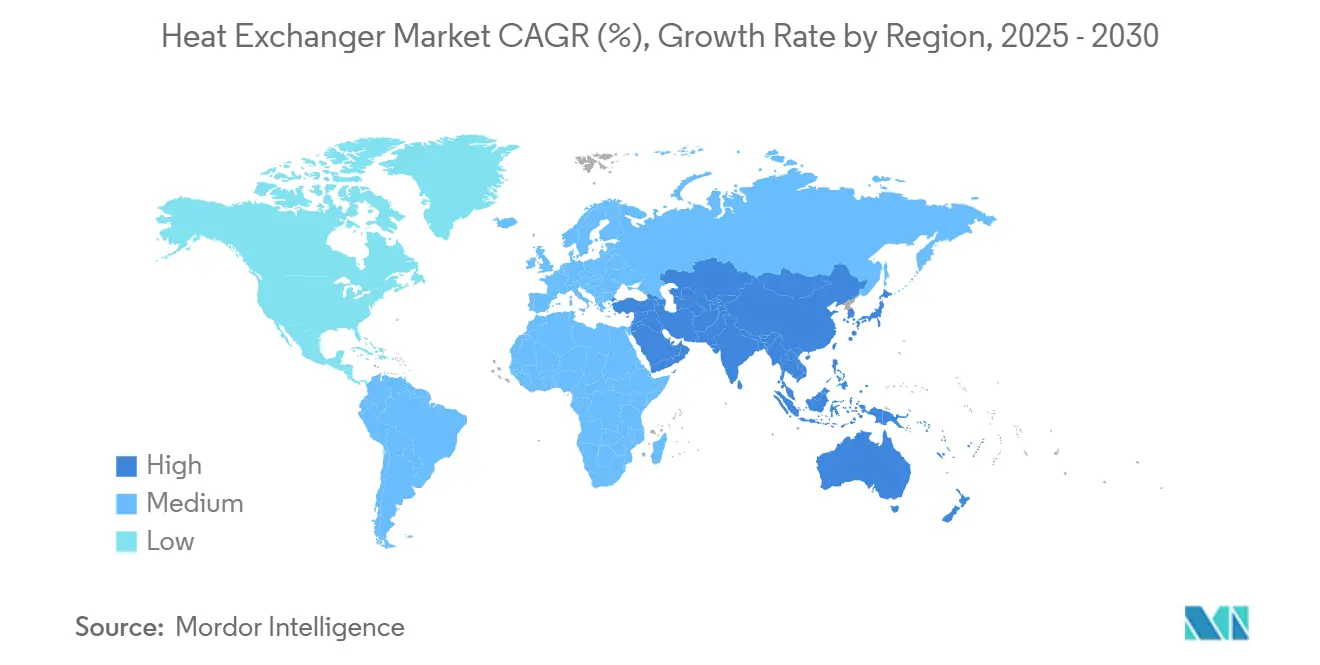
Heat Exchanger Market Analysis by Mordor Intelligence
The Heat Exchanger Market size is estimated at USD 18.28 billion in 2025, and is expected to reach USD 23.54 billion by 2030, at a CAGR of 5.19% during the forecast period (2025-2030).
Heat exchanger market growth is fueled by LNG infrastructure build-outs, data-center liquid-cooling adoption, and regulations that force efficiency upgrades in industrial boilers and district energy networks. Shell-and-tube systems remain the mainstay for high-pressure duties, yet air-cooled equipment is scaling rapidly as water conservation drives procurement decisions. Exotic alloy demand rises in line with hydrogen pilot projects and super-critical CO₂ power cycles, while modular printed-circuit designs gain traction where extreme pressures converge with space constraints. Competitive dynamics stay moderately fragmented: global incumbents rely on broad portfolios and aftermarket reach, whereas specialists target niches such as cryogenic LNG trains and 200-bar hydrogen units.
Key Report Takeaways
- By technology, shell-and-tube units led with 35% of heat exchanger industry share in 2024; air-cooled variants are projected to post a 6% CAGR to 2030.
- By material, stainless steel accounted for 30% of the heat exchanger market size in 2024, while exotic alloys, including titanium and nickel, are forecast to expand at a 6.5% CAGR through 2030.
- By flow arrangement, counter-current designs captured 65% share of the heat exchanger industry in 2024; cross-flow configurations are growing at 6% CAGR to 2030.
- By end-use industry, the chemical and petrochemical sector held 30% of the heat exchanger industry share in 2024 and is progressing at a 6.5% CAGR during 2025-2030.
- By geography, Europe dominated with 33% revenue share in 2024; Asia-Pacific is set to record the fastest regional CAGR at 5.9% through 2030.
Global Heat Exchanger Market Trends and Insights
Drivers Impact Analysis
| Driver | (~) % Impact on CAGR Forecast | Geographic Relevance | Impact Timeline |
|---|---|---|---|
| Surge in LNG liquefaction projects boosting demand for cryogenic exchangers | +1.2% | North America & Middle East | Medium term (2-4 years) |
| District-cooling expansion in GCC & SE-Asia driving plate-frame sales | +0.8% | GCC & Southeast Asia | Short term (≤ 2 years) |
| Hydrogen pilot plants adopting printed-circuit exchangers for 200-bar service | +0.6% | Europe & North America | Long term (≥ 4 years) |
| Mandatory EU industrial boiler upgrades spurring retrofit tube bundles | +0.9% | Europe | Medium term (2-4 years) |
| SMR (small modular reactor) roll-out needing compact safety-class exchangers | +0.4% | North America & Europe | Long term (≥ 4 years) |
| Data-centre liquid cooling uptake accelerating micro-channel adoption | +1.1% | Global, focus on North America & Asia-Pacific | Short term (≤ 2 years) |
| Source: Mordor Intelligence | |||
Surge in LNG Liquefaction Projects Boosting Demand for Cryogenic Exchangers
Global build-outs of mid-scale and large LNG trains require coil-wound and plate-fin units that perform below –150 °C while maintaining tight thermal approaches, accelerating procurement of high-grade stainless steels and aluminum alloys [1]Linde plc, “Liquefaction Technologies for Mid-Scale LNG,” linde.com. Modular exchanger skids shorten construction schedules and curb cost overruns, benefiting fabricators integrating 3D-printed flow plates for weight reduction and enhanced turbulence. During 2025-2026, Gulf Coast and Qatari megaprojects are expected to anchor the heat exchanger industry, with secondary demand arising from brownfield debottlenecking across Asia. Suppliers that certify to ASME Section VIII while offering 12-week delivery windows will secure framework contracts as EPC firms standardize equipment lists to de-risk timelines.
District-Cooling Expansion in GCC & Southeast Asia Driving Plate-Frame Sales
High-humidity metros such as Dubai, Riyadh, and Singapore continue to subsidize district-cooling systems to shave peak power loads, prompting utilities to specify gasketed plate-frame exchangers owing to compact footprints and easy capacity scaling [2]International Energy Agency, “District Cooling: Technology Brief,” iea.org. These deployments rely on stainless and titanium plates to mitigate brine corrosion, with district operators demanding 99% availability guarantees. OEMs that bundle condition-monitoring sensors will capture recurring service revenue as concession operators pivot toward performance-based maintenance models.
Hydrogen Pilot Plants Adopting Printed-Circuit Exchangers for 200-Bar Service
Electrolyzer clusters in the United Kingdom, Germany, and California specify PCHEs because micro-photochemically etched channels provide high surface-to-volume ratios and withstand 200-bar pressures without bulk weight penalties [3]Tempco, “Printed Circuit Heat Exchangers for Hydrogen,” tempco.com. Titanium and Hastelloy plates mitigate hydrogen embrittlement risks, while diffusion-bonded blocks permit modular stacking. Early adopters are embedding fiber-optic temperature sensors that allow digital twins to optimize duty cycles—an investment justified by higher electrolyzer uptime.
Data-Centre Liquid-Cooling Uptake Accelerating Micro-Channel Adoption
AI training clusters drive rack power densities past 80 kW, forcing hyperscale operators to adopt rear-door heat exchangers and direct-to-chip cold plates that use micro-channels with sub-1 mm hydraulic diameters. Compared with air cooling, liquid systems cut energy use by more than 20%, freeing PUE headroom for compute expansion. Component vendors that offer quick-disconnect manifolds and low-GWP dielectric fluids gain an edge as retrofit projects proliferate across North America and East Asia.
Restraints Impact Analysis
| Restraint | ( ~ )% Impact on CAGR Forecast | Geographic Relevance | Impact Timeline |
|---|---|---|---|
| Nickel & titanium price volatility inflating corrosion-resistant units | -0.7% | Global, acute in Asia-Pacific manufacturing hubs | Short term (≤ 2 years) |
| Bio-process fouling issues limiting adoption in biorefineries | -0.3% | North America & Europe biofuels clusters | Medium term (2-4 years) |
| EPC demand for 12-week lead-times curbing engineered-to-order designs | -0.5% | Global, especially mega-project regions | Short term (≤ 2 years) |
| Direct air-cooling in power plants cannibalising air-cooled exchangers | -0.4% | Arid geographies facing water scarcity | Medium term (2-4 years) |
| Source: Mordor Intelligence | |||
Nickel and Titanium Price Volatility Inflating Corrosion-Resistant Units
Class 1 nickel and aerospace-grade titanium prices have swung by up to 35% quarter-on-quarter since 2024, undermining order pipelines for hydrogen, marine, and offshore projects that cannot down-spec materials. Fabricators pass surcharges to EPC clients, but budget overruns trigger project deferrals, trimming short-term volumes in the heat exchanger industry. Stainless-steel clad plates partly offset exposure, yet diffusion bonding of dissimilar metals complicates weld integrity certification.
Bio-Process Fouling Issues Limiting Adoption in Biorefineries
Complex organic streams in hydrothermal liquefaction deposit polysaccharides and salts on heat-transfer surfaces, dropping overall duty by up to 25% between cleaning cycles. Shell-side chemical washing, while effective, extends downtime beyond economic thresholds for small biorefineries. Laser-textured surfaces and fluoropolymer liners offer potential remedies but remain cost-prohibitive for first-generation biofuel plants operating on thin margins.
Segment Analysis
By Type: Shell and Tube Dominance Faces Air-Cooled Challenge
Shell-and-tube designs retained 35% of the heat exchanger industry share in 2024, upholding their position as the default choice where pressures exceed 60 bar and fouling margins are high. Their standardized TEMA classifications simplify specification for refineries, LNG pretreatment trains, and sulfur recovery units, supporting repeat orders for tube bundles and gaskets that underpin aftermarket revenues. At the same time, air-cooled variants are climbing at a 6% CAGR as water-stressed utilities in India, Texas, and the Middle East prioritize zero-liquid-discharge strategies, driving units with forced-draft fans and low-noise gearboxes.
Across 2025-2030, printed-circuit and spiral-wound formats will nibble share in high-pressure hydrogen and super-critical CO₂ cycles as designers seek compact footprints that conventional shells cannot match. Nevertheless, the heat exchanger market will continue to favor shell-and-tube for brownfield revamps because existing nozzle locations fit retrofit bundles, keeping life-cycle costs predictable. Suppliers that blend stainless-steel shells with copper-nickel tubes for marine scrubbers will tap IMO 2020 compliance budgets, adding a modest lift to volumes.

Note: Segment shares of all individual segments available upon report purchase
By Material of Construction: Stainless Steel Leadership Challenged by Exotic Alloys
Stainless steel maintained 30% of the heat exchanger industry in 2024 because grades such as 316L balance corrosion resistance and cost efficiency. In food, beverage, and pharmaceutical lines, sanitary finishes and low-carbon content fulfill regulatory mandates without premium alloy surcharges. Exotic alloys—titanium, nickel, Incoloy, and Hastelloy—are moving at a 6.5% CAGR through 2030, capturing hydrogen, desalination, and offshore wind converter platforms where chloride-rich brines or hydrogen embrittlement preclude stainless options.
Polymers and composites grow from a small base as PTFE and graphite blocks outperform metals under highly acidic or fluoride-laden streams, notably in semiconductor wet-etch and lithium-ion battery recycling. Additive manufacturing unlocks dual-material lattices that place high-alloy material only where corrosion is severe, trimming cost and weight. Such innovations cement the heat exchanger industry’s transition toward application-specific metallurgy rather than defaulting to legacy stainless catalogues.
By Flow Arrangement: Counter-Current Dominance Meets Cross-Flow Innovation
Counter-current flow retained a dominant 65% share of the heat exchanger industry in 2024 since it maximizes log-mean temperature difference and minimizes approach temperatures, crucial for waste-heat recovery from FCC units and combined-cycle HRSGs. Cross-flow equipment is scaling at 6% CAGR, exploiting reduced footprint and single-side access that simplifies cleaning in air-fin bundles across petrochemical and fertilizer plants in deserts.
Hybrid multi-pass designs combine counter-current cores with cross-flow extensions to balance pressure drop with outlet temperature requirements, particularly in small modular reactor (SMR) steam generators. Growth in these configurations will accelerate as CFD-driven workflows shorten design loops, allowing OEMs to tailor performance without extending lead times—an increasingly important differentiator as EPC contracts stipulate 12-week delivery caps.
By End-Use Industry: Chemical and Petrochemical Sector Drives Growth
Chemical and petrochemical operations accounted for 30% of the heat exchanger market share in 2024 and will grow at a 6.5% CAGR, powered by process-intensification retrofits that demand higher heat-flux densities and smaller footprints. Continuous catalyst reformers and olefins plants switch to plate-type exchangers to curb energy intensity, while turnaround intervals dictate quick-change gasket kits to minimize downtime.
Both fossil and renewable power—generation applications continue to specify compact heat-exchanger modules for thermal-energy storage and condenser upgrades, especially as direct-air-cooling spreads in arid grids. In nuclear, safety-class units utilizing nickel-base superalloys support SMR rollouts, reflecting the industry trend toward compactness and passive safety. Food & beverage maintains demand for sanitary, CIP-enabled designs; meanwhile, electric-vehicle thermal loops represent an emerging revenue stream for micro-channel condensers.

Note: Segment shares of all individual segments available upon report purchase
Geography Analysis
Europe commanded 33% of 2024 global revenue, propelled by EU Eco-design directives that push boiler retrofits and district energy rollouts. Germany’s integrated hydrogen strategy channels funding toward printed-circuit prototypes for electrolyzer plants, anchoring a high-value corner of the heat exchanger industry. France accelerates SMR projects that require compact safety-class exchangers, while Nordic countries pioneer low-temperature district loops using titanium plate packs to exploit ambient seawater. OEMs maintaining EN13445 pressure-vessel accreditations and in-region spare-parts hubs capture share as uptime guarantees dominate tender scoring.
Asia-Pacific posts the fastest 5.9% CAGR to 2030, with China’s petrochemical capacity additions, India’s expanding power fleet, and ASEAN district-cooling concessions underpinning volume growth. Domestic manufacturers leverage cost-advantaged supply chains to win shell-and-tube orders, while Japanese and Korean firms focus on titanium and nickel PCHEs for ammonia-cracking pilots. Local EPCs value suppliers that offer modular skids shipped within 10 weeks, compelling global brands to localize fabrication or risk losing relevance amid aggressive pricing in the heat exchanger industry.
North America benefits from LNG export terminals along the Gulf Coast and data-center campus expansions across Virginia, Texas, and Quebec. The US Department of Energy’s hydrogen hubs funnel grants into PCHE demonstrations that use diffusion-bonded nickel alloys strengthening the regional heat exchanger industry. Canada’s oil-sands operators retrofit air-fin units to curtail water withdrawals, creating a secondary pull on fan-assisted equipment. Across Latin America, mining concentrates and solar-thermal plants drive boutique orders, whereas the Middle East leans on desalination and petrochemical mega-complexes to sustain demand. Africa’s momentum remains gradual but steady, tied to copper-belt smelting upgrades.

Competitive Landscape
Heat exchanger suppliers operate in a moderately fragmented arena where scale and specialization confer advantages. Leading companies in the heat exchanger industry such as Alfa Laval, Danfoss, and GEA Group defend their positions through global service footprints, in-house plate-pressing capacity, and proprietary surface enhancements that raise overall heat-transfer coefficients. These incumbents pursue bolt-on acquisitions to access printed-circuit or micro-channel intellectual property, mirroring Dover Corporation’s strategy of folding niche innovators into broader sustainability platforms.
Licensing models permitting local fabrication under a Western brand look set to intensify as carbon-tracking regulations prompt buyers to ask for regional supply footprints in heat exchanger industry.
Mid-tier specialists such as Heatric and Thermex carve out positions in hydrogen and super-critical CO₂ niches by leveraging additive manufacturing to produce complex channel topologies unachievable via conventional machining. Start-ups focus on polymer and ceramic exchangers for corrosive semiconductor chemicals, betting that ultralow contamination benefits outweigh higher capital cost. Regional manufacturers in China and India compete on price and delivery time in the commoditized shell-and-tube segment, often benefiting from state-backed financing that lowers working-capital burden.
Service differentiation remains an under-exploited moat: predictive-maintenance software that meshes vibration data with cloud analytics unlocks value-added revenue streams as OPEX budgets eclipse CAPEX spending for many process operators. Cyber-secure sensor suites will therefore become table stakes over 2026-2028, with OEMs bundling IIoT gateways into new-build contracts. Licensing models permitting local fabrication under a Western brand look set to intensify as carbon-tracking regulations prompt buyers to ask for regional supply footprints in heat exchanger industry
Heat Exchanger Industry Leaders
-
Alfa Laval AB
-
Kelvion Holding GmbH
-
Danfoss A/S
-
GEA Group AG
-
SPX Flow Inc.
- *Disclaimer: Major Players sorted in no particular order

Recent Industry Developments
- June 2025: California Energy Commission funded next-gen heat-pump R&D featuring polymer microchannel exchangers that promise 8-20% cost cuts against metal counterparts.
- April 2025: ASME researchers simulated Z-shaped silicon-carbide PCHEs for super-critical CO₂ energy storage; modeling indicated 12% smaller footprints than Inconel baselines.
- March 2025: Dover Corporation’s Climate & Sustainability division booked USD 1.6 billion in revenue from aftermarket service contracts for plate-frame exchangers.
- January 2025: Jones Lang LaSalle reported that global data-center energy demand may double within five years, making rear-door and direct-to-chip liquid-cooling heat exchangers standard for AI workloads.
Research Methodology Framework and Report Scope
Market Definitions and Key Coverage
Our study defines the global heat exchanger market as all newly manufactured equipment that transfers heat between two stationary fluids through a solid wall, including shell-and-tube, plate-frame (gasketed, brazed, welded), air-cooled, regenerative, and printed-circuit units. According to Mordor Intelligence, we value shipments to process industries, power stations, HVAC installations, and district-energy schemes at factory-gate prices.
Scope exclusions include after-market bundles, vehicular micro-channel units made solely for passenger-car HVAC loops, and standalone boiler economizers, which lie outside this scope.
Segmentation Overview
- By Type
- Shell and Tube
- Plate and Frame (Gasketed Plate, Brazed Plate, Welded Plate)
- Air-Cooled (Fin and Tube, Plate-Fin, Micro-Channel)
- Regenerative (Rotary and Plate)
- Printed Circuit
- Others (Double-Pipe, Spiral, Coaxial)
- By Material of Construction
- Stainless Steel
- Carbon Steel
- Non-Ferrous (Copper, Aluminium)
- Exotic Alloys (Titanium, Nickel, Hastelloy)
- Polymers and Composites (PTFE, Graphite, Ceramic)
- By Flow Arrangement
- Counter-Current
- Parallel
- Cross-Flow
- Hybrid/Multi-Pass
- By End-Use Industry
- Oil and Gas
- Chemical and Petrochemical
- Power Generation (incl. Nuclear)
- Food and Beverage
- Pulp and Paper
- Water and Waste-water Treatment
- Other Industries (Automotive and Transportation, Metallurgy, Mining, HVACR, Pharmaceutical and Biotechnology)
- By Geography
- North America
- United States
- Canada
- Mexico
- Europe
- United Kingdom
- Germany
- France
- Italy
- Spain
- Nordic Countries
- Russia
- Rest of Europe
- Asia-Pacific
- China
- India
- Japan
- South Korea
- ASEAN Countries
- Australia
- Rest of Asia-Pacific
- South America
- Brazil
- Argentina
- Chile
- Colombia
- Rest of South America
- Middle East and Africa
- Saudi Arabia
- United Arab Emirates
- South Africa
- Egypt
- Rest of Middle East and Africa
- North America
Detailed Research Methodology and Data Validation
Primary Research
Mordor analysts interviewed plant engineers, EPC contractors, OEM sales managers, and regional distributors across North America, Europe, Asia-Pacific, and the Middle East. These conversations tested desk-derived ratios, clarified average exchanger surface area per installation, and captured early signals on alloy shifts and regulation-driven retrofits.
Desk Research
We start by mapping demand using open datasets from the International Energy Agency, Eurostat, the U.S. Energy Information Administration, UN Comtrade, and the European Chemical Council. Trade-body white papers, patent filings, and safety directives reveal technology shifts that alter effective surface-area demand. Company filings, prospectuses, and investor decks let our team align producer capacity with revenue splits, while D&B Hoovers and Dow Jones Factiva provide cross-checks on product mix.
Import-export shipment logs from Volza and global tender portals such as Tenders Info highlight upcoming capacity additions that feed near-term volume estimates. The sources listed are illustrative only; many additional public and proprietary references informed data collection, validation, and clarification.
Market-Sizing & Forecasting
We employ a top-down demand-pool model anchored on industrial gross fixed capital formation, new utility power capacity, district-cooling build-outs, and chemical output indices. We then corroborate results with selective bottom-up checks on vendor shipments and sampled average selling prices. Key variables like steel price indices, refiner utilization rates, plate-exchanger penetration, environmental efficiency mandates, and LNG liquefaction investments feed a multivariate regression with ARIMA overlays to project volumes through 2030. When supplier roll-ups under-report emerging-market volumes, ratio imputation against import values bridges the gap before final consolidation.
Data Validation & Update Cycle
Every draft passes variance screening, peer review, and a final recalibration against external signals. The model refreshes each year, with interim updates triggered by material events such as large petrochemical FIDs or sharp metal-price swings.
Why Mordor's Heat Exchanger Baseline Metrics Inspire Confidence
Published figures often diverge because some firms bundle aftermarket parts, micro-segment niches, or forward order books into headline values.
Key gap drivers include broader HVAC coverage, inclusion of replacement coils, differing currency bases, and longer refresh cycles used elsewhere, whereas Mordor reports only new-equipment revenue in constant 2025 dollars and revisits its model every twelve months.
Benchmark comparison
| Market Size | Anonymized source | Primary gap driver |
|---|---|---|
| USD 18.28 B (2025) | Mordor Intelligence | |
| USD 23.95 B (2025) | Global Consultancy A | Includes aftermarket & service contracts, wide HVAC component set |
| USD 19.72 B (2025) | Trade Journal B | Uses 2024 FX rates, counts automotive micro-channel exchangers |
| USD 20.16 B (2024) | Industry Association C | Relies on shipment-weight proxies, five-year refresh cadence |
Taken together, our disciplined scope selection, transparent variables, and annual update cadence give decision-makers a dependable baseline that remains traceable, testable, and ready for real-world planning.
Key Questions Answered in the Report
What is the current size of the heat exchanger industry?
The heat exchanger market is valued at USD 17.47 billion in 2024 and is forecast to reach USD 23.54 billion by 2030.
Which region is expanding fastest in the heat exchanger industry?
Asia-Pacific records the quickest growth, clocking a 5.9% CAGR through 2030 thanks to manufacturing expansion in China and India.
Which technology type holds the largest heat exchanger market share?
Shell-and-tube exchangers lead with 35% share in 2024 due to their reliability in high-pressure duties.
How are data centers influencing heat exchanger industry?
AI-driven data centers are adopting liquid cooling, spurring demand for micro-channel and rear-door heat exchangers that manage high rack densities.
Why are exotic alloys gaining traction in heat exchangers industry?
Hydrogen projects and super-critical CO₂ power cycles require materials like titanium and Hastelloy to withstand extreme pressures and corrosive environments.
What is the biggest restraint facing the heat exchanger industry?
Volatility in nickel and titanium prices is inflating costs for corrosion-resistant units, dampening near-term investment particularly in Asia-Pacific.
Page last updated on:



